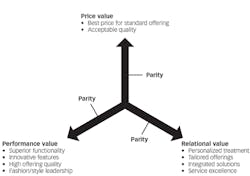How do we assess customer value in dentistry?
We have all seen the seminars and the Facebook posts that promise to show us how to change our pricing, move away from insurance, and work fewer hours with more pay. This series of four articles will analyze how consumers calculate customer value, and then dive into the three vectors of value (price, performance, relationship) your patients are using to make choices on care (figure 1).
Private practice dentistry is facing considerable competition from the consolidation of practices under DSO umbrellas that reduce their expenses and offer lower fees to patients, do-it-yourself competitors in orthodontics, and insurance companies tightening their grip on our revenues. I embarked on a journey through MBA studies from 2015 to 2017 to gain more in-depth knowledge and share this knowledge with my profession. My goal in sharing this knowledge is to provide those wanting to pursue private practice with the tools to not just exist but to excel in their endeavors.
Figure 1: Vectors that influence market perceived values
Professor George Day, a marketing professor at the Wharton School at the University of Pennsylvania, and his colleague Christine Moorman at the Fuqua School of Business at Duke University, authored a book entitled Strategy from the Outside In.Their book takes the reader on a tour of how to determine the motivations of patients and what to do with that information. I will take a small section of this book that discusses customer value and the accompanying value vectors, along with other sources, to help flesh out the understanding of these concepts for your practice.
We will start with the overall concept of customer value and use an equation to help you organize the interplay of the different factors in measuring the customer value of services we provide. When we investigate a new item for our offices, how do we make that decision? What benefits will we receive from that purchase? What are the initial and ongoing monetary and temporal costs of that decision? What risks do we weigh before we make that decision to purchase?
These are all the same questions your patients are asking themselves. Dental offices want a value for the items they purchase just as patients want a value for the services they seek. This value does not mean the cost of the service, but rather the total customer value dynamic we are addressing. Let’s review and expand on an equation that helps define the concept of customer value (figure 2).
This equation does not mention price per se. Total lifecycle costs in this equation are not only monetary, but also include the time and effort incurred by the patient. Customer value and price are positively correlated but not directly linked. Price is something you determine after you realize where your product falls in your customer’s hierarchy. We will fully discuss the pricing dynamic in a subsequent article. You will also notice the word “perceived” precedes all of the items measured. The use of the word “perceived” implies that the practice cannot make these evaluations in a vacuum and must seek out and gather patient feedback. The best way to quantify the pieces of the equation is to survey your patients to determine where you stand and what you can improve upon to increase customer value perceptions of your practice.
We will first discuss the portion of the customer value equation inside the brackets in Figure 2. Customer benefit in dentistry outlines the overall pain point you are going to solve for the patient. Examples include alleviation of pain, mitigation of future pain, and providing esthetic solutions the patient desires. We will focus on providing an esthetic solution for our example in this series.
The perceived benefit for the patient of an esthetic solution can range from increased self-esteem to improving job prospects and everything in between. This benefit can be communicated to patients, but frequently patients make this final calculation of benefit on their own. The perceived total lifecycle costs for dental services include initial monetary cost, time to have the procedure performed, effort to pursue the procedure with your office, and the length of time the purchase is meant to last.
The purpose of this equation is not to place actual integers in these fields but to understand that the perceived benefit must be higher than the perceived total lifecycle cost if the customer is to glean any value from the service. How you communicate your offerings can have an effect on the weight given to the measurements mentioned.
Once the relationship between customer benefit and total lifecycle costs is established to be positive, the customer must then determine if your practice is the one to use. Customers frequently base decisions on services on the reputation of the provider, the comfort they feel with the presentation of material, and the risk of repeating the service to achieve an optimal result. This perceived risk plays a large effect on what you as a provider can do to increase the customer value of the services you are offering. For example, if patients present to your office and have determined they highly value their need for esthetic improvement, and the total lifecycle costs are not an issue for them, your challenge is to remove as much perceived risk as possible to ensure you are providing the highest customer value.
Does the increased customer value translate into a much higher price point for your services? Perhaps, but the price increase could be replaced by a more reasonable price point, resulting in more referrals and allowing you to eliminate certain insurances from your office or to establish yourself in your new practice. When a patient perceives a risk of zero, you are able to capture 100% of the benefits minus costs that the patient is willing to invest in achieving the desired benefit.
In the next three articles we will expand upon the value vectors of price, performance, and relationship. These three value vectors will be used to help readers see how to become more competitive in their local marketplace when the customer value exists but there is not a clear differentiation between providers.
Bill Layman, DMD, MBA, attended dental school the Medical University of South Carolina after serving with the 82nd Airborne Division. He then completed his orthodontic residency at Vanderbilt University. After starting a paperless, digital orthodontic office, he went back to school and completed an MBA at the Wharton School of Business at the University of Pennsylvania. He currently devotes his efforts to helping others develop fully digital workflows, reduce reliance on outside aligner companies, and evaluate technology investment decisions.



